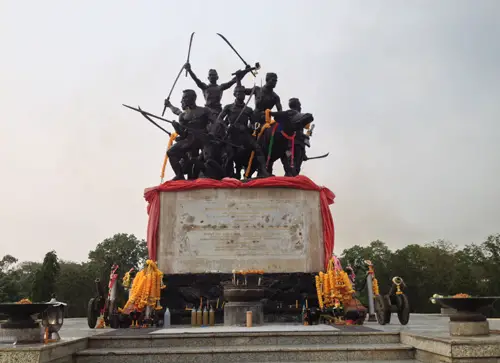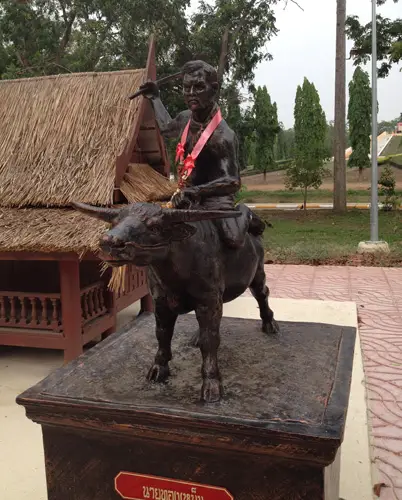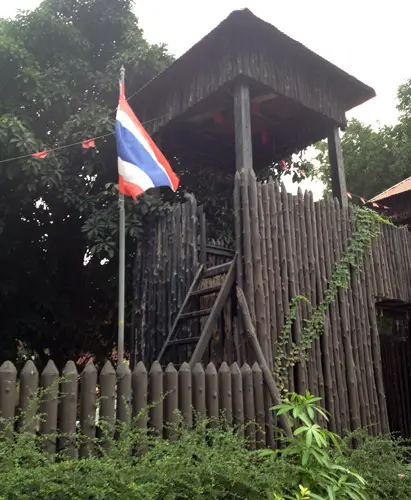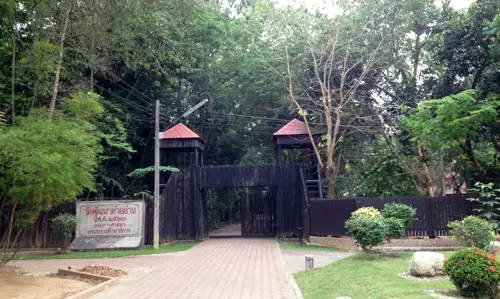Quite often we watch historical movies and end up remembering how the story goes from the movie rather than from the history books. But even the detailed history books are written with a specific agenda in mind and are often just as much influenced by propaganda as historical movies are. In Thailand, one such case is the story surrounding Bang Rachan, a historical village north of Bangkok, nowadays situated in Sing Buri Province.
The story goes that during the Burmese-Siamese War of 1765-1767, which ended in the sacking of Ayutthaya by the Burmese army, thus bringing down a Kingdom of Siam that had existed for slightly more than 400 years, a small village northwest of the Siamese capital of Ayutthaya managed to withhold the advancing Burmese army for up to five months through sheer determination, patriotism, and heroism. The idyllic images of the Siamese villagers fighting and dying for their land, which were brilliantly portrayed in Bang Rajan movies (1966 and 2000), have by now been so much ingrained in popular Thai culture that ordinary Thai people and uninformed foreigners take the story for granted and attribute it to actual, sound, historical facts.
While the purpose of this article is not to debate the role of fact and fiction in Thai historical cinematography, viewers and readers should be critical about what they see on the screen and what they read in condensed history books (both in Thai and English). As a matter of fact, historical revisionism was a point of concern that was raised many decades ago, when Damrong Rachanubhab, who is considered the father of Thai history, had brought up the issue of debating the historical accuracy of the Bang Rachan story details, as they are accepted today in popular culture.
Obviously, academic writings and historical anecdotes, all full of details, dates and names hard to remember and connect to, are far less popular with the public than Thanit Jitnukul’s highly successful movie adaptation of Bang Rajan (2000). This further engrained in the viewer’s minds the “fantasy” of the handsome, mustachioed, hair gelled rice-planting villager with the perfect six-pack who also happens to be an expert in wielding two swords simultaneously! And let’s not forget Carabo’s very catchy song, Bang Rachan, which you can now sing along to, using the karaoke version on YouTube.
To make matters even more “official,” the seal of Sing Buri province depicts the leaders of Bang Rachan, whose eleven names, appearance, and weapons they were specialized in are clearly “documented” – sarcasm intended – in Thai historiography. Even (part of) the nickname of Sing Buri province banks on the very same story: “Land of Heroes and Courageous People.” The old seal of the province, replaced with the new one in 2004 (after the completion of the monument dedicated to the eleven leaders), was a crude drawing of the Fort of Khai Bang Rachan and there is also a modern structure built in remembrance of the Bang Rachan episode.
So, you can imagine that when traveling to Sing Buri, you’ll be inundated with reminders of the Bang Rachan story. Kudos must go to the TAT (Tourist Authority of Thailand) and the local administration who have managed to make good of all this patriotic propaganda and have transformed Sing Buri into a province well worth visiting both for its (pseudo)historic appeal and the many temples that are dotted throughout its six districts.
The Bang Rachan story also includes strong elements of Buddhism and mysticism, with some importance given to Thammachot’s role in the whole affair. He was a Buddhist monk who was regarded highly by the villagers for his powerful spells and charms, so it is only natural to add to your travel itinerary at least one temple stop. So, in addition to exploring the compound housing the Heroes of Khai Bang Rachan Monument and Khai Bang Rachan Park, I also recommend exploring the grounds of Wat Pho Kao Ton, which is described in some detail below.
The main attraction of Bang Rachan Memorial Park is obviously the statue of the eleven leaders who fought alongside the other villagers to repel the Burmese army. They all met their death in a heroic (and bloody) fashion, while the powers to be in Ayutthaya preferred to not send their standing army or even weapons (canons were much needed to bring down the forts built by the Burmese army) and just waited behind the perceived safety of Ayutthaya’s walls for the enemy to come to their gates. After dealing with the rogue villagers, which took eight different battles, the Burmese army eventually did knock on the gates of Ayutthaya or, more exactly, they knocked them down, and subsequently burned and pillaged everything in their way.
The park in Sing Buri also contains a beautiful sala (Thai pavilion) where one can take a rest; there is a museum with three exhibition rooms; a mock-up village with mini-statues for every hero; a jump-tower (off-limits for non-scheduled visitors); a small obstacle course made up of hanging planks, and a playground. Phongsak Meesiri’s three sculptures further bring tribute to the villager’s sacrifices and awesome courage. The park’s huge car-park is also proof that the place is obviously very popular with the Thais although, it must be noted that some areas of the park are certainly in dire need of a facelift.
Right across the road, there’s Klai Bang Rachan Park which is comprised of several zones of interest. Among these, worth taking the time to explore is Wat Pho Kao Ton, which venerates Thammachot and sells sacred amulets called Roop Lor; there is a vihara (refuge for wondering monks) where you can add gold leaves to Thammachot’s statue; a pond where the same monk blessed holy water for the Bang Rachan warriors (you can refill the pond by carrying water to it from a nearby well); and a few chedis which were built for the souls of all the Burmese army who were slain by the villagers.
Wat Pho Kao Ton means “The Temple of the Nine Bodhi Trees” and nine Bodhi Trees can be seen growing by the side of the main wall of the park. These trees have a special significance for Buddhists worldwide as it is believed that Siddharta Gautama, who became the Lord Buddha, reached his enlightenment under one of them. Further down into the park, an arboretum (a garden devoted to trees) surrounded by a mock-up wall and bordered by the Chao Phraya River leads you to a peaceful zone full of trees and various flower species that are specific to the area.
From Bangkok, you can reach Sing Buri province by bus from the Northern Terminal Bus Station on Kamphaeng Phet 2 Road where one air-conditioned bus makes the 140-kilometre trip there daily. Once you reach Sing Buri, any motorbike taxi will be able to take you to the three attractions described above. They are located in Amphoe Khai Bang Rachan, 13-kilometres southwest of the town on Route No.3032.
A shorter version of this article was initially published in Mango Metro (August 2014, Vol.8, No.9)







